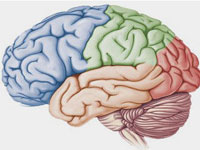近日,国际著名学术期刊《当代生物学》(Current Biology)以专题论文(featured article)形式发表了中国科大合肥微尺度物质科学国家实验室和生命科学学院周逸峰研究组与美国南加州大学吕忠林教授的合作研究成果。该研究揭示知觉学习可以引起初级视皮层细胞相应反应特性的改变。
知觉学习是个体从外界环境中提取信息提高能力的过程,反映了成年神经系统可塑性,研究知觉学习的细胞、分子机制,充分发掘该可塑性,可用于脑认知损伤和感知觉缺陷等患者的无创脑功能恢复治疗。虽然一般认为知觉学习可引起早期皮层的改变,但目前有关生理学证据很少。为了揭示知觉学习的生理学基础,周逸峰研究员课题组与美国南加州大学吕忠林教授合作,结合心理物理学测量和麻醉状态下胞外单细胞记录的方法分别检验了猫对比度辨别训练对知觉表现和神经元的对比度敏感方程的影响。
他们发现,训练显着提高了猫对其空间频率在训练空间频率附近光栅的知觉对比敏感度,且训练眼效果更强。与行为学评测一致的是,训练组猫V1区神经元的平均对比敏感度显着高于未训练组。对于所有的训练组和非训练组猫,来自单个神经元的对比敏感度方程与行为学测定的知觉的对比敏感度方程高度相关。
研究结果表明,行为学测定的知觉对比敏感度改善归因于训练诱导的V1区细胞对比度增益的提高。
推荐原文出处:
Current Biology DOI:10.1016/j.cub.2010.03.066
Perceptual Learning Improves Contrast Sensitivity of V1 Neurons in Cats
Tianmiao Hua, Pinglei Bao, Chang-Bing Huang, Zhenhua Wang, Jinwang Xu, Yifeng Zhou, Zhong-Lin Lu
Background
Perceptual learning has been documented in adult humans over a wide range of tasks. Although the often-observed specificity of learning is generally interpreted as evidence for training-induced plasticity in early cortical areas, physiological evidence for training-induced changes in early visual cortical areas is modest, despite reports of learning-induced changes of cortical activities in fMRI studies. To reveal the physiological bases of perceptual learning, we combined psychophysical measurements with extracellular single-unit recording under anesthetized preparations and examined the effects of training in grating orientation identification on both perceptual and neuronal contrast sensitivity functions of cats.
Results
We have found that training significantly improved perceptual contrast sensitivity of the cats to gratings with spatial frequencies near the trained spatial frequency, with stronger effects in the trained eye. Consistent with behavioral assessments, the mean contrast sensitivity of neurons recorded from V1 of the trained cats was significantly higher than that of neurons recorded from the untrained cats. Furthermore, in the trained cats, the contrast sensitivity of V1 neurons responding preferentially to stimuli presented via the trained eyes was significantly greater than that of neurons responding preferentially to stimuli presented via the untrained eyes. The effect was confined to the trained spatial frequencies. In both trained and untrained cats, the neuronal contrast sensitivity functions derived from the contrast sensitivity of the individual neurons were highly correlated with behaviorally determined perceptual contrast sensitivity functions.
Conclusions
We suggest that training-induced neuronal contrast gain in area V1 underlies behaviorally determined perceptual contrast sensitivity improvements.








